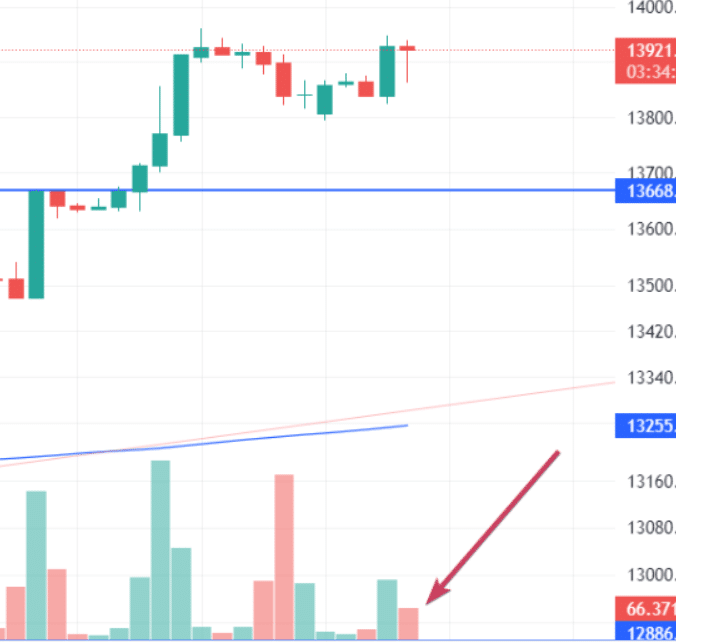Volume represents the first significant indicator that requires proper interpretation. It provides crucial information about market participants and their activity over time. Additionally, volume is closely related to volatility.
Volume is the number of shares (or other financial instruments like commodities) traded within a specific time period. If we’ve looked at a 15-minute chart, our chart will measure the volume traded in each 15-minute period.
Looking at the chart below, we can note that during that day, 66,000 NQ contracts were traded. The red coloring of the volume on that day doesn’t necessarily imply that there were more sellers than buyers. It’s important to remember that each transaction requires a corresponding sale and purchase, as one can’t happen without the other. Therefore, for a sale to occur, there must be someone willing to buy, and vice versa.
The volume itself only reflects trading activity, such as the number of shares or contracts traded. To know if it’s indicative of demand or supply, you need to look at the outcomes of all this activity on price. In other words, there isn’t a “buy” volume or a “sell” volume; there’s only volume. What drives the price up isn’t that purchases have exceeded sales, but that demand was present at every price move, and supply was willing to participate in every price increase.

The Importance of Volume
Higher volumes accompany an upward/downward trend, making it a good indicator of a strong trend confirmation. If there are low volumes, there might still be a trend, but it’s not as representative of the overall picture. Dow theory assumes that volume accompanies price movements as an indicator. It’s a secondary indicator that confirms price movements and therefore confirms the trend: volume should increase as price trends rise or fall, indicating more people getting involved.
Volume is useful to indicate not only the trend but also trend reversals. If we have a price decline below a support level accompanied by higher-than-usual volume, this could signal a trend reversal. If volume is weak, perhaps the trend isn’t set for a reversal after all. Thus, it’s useful to understand the general psychological state of the market.
Charts: Volume is also plotted alongside the chart, usually below the price chart. Volume is defined as the number of shares or contracts traded in a ticker during a specific time period. Therefore, the volume chart can be plotted based on the selected time frame. In other words, an hourly chart will show the total volume traded in an hour; a daily chart will reflect the volume during the day, a weekly chart will show the volume for the entire week, and so on.
Theories: The first theory is that volume typically follows a trend. Since a bullish or bearish phase is usually triggered by greater interest, it’s natural that volume would also increase during this time. However, if volume continues to decrease as the price steadily moves up or down, it should serve as a warning to investors. This indicates that the bullish or bearish phase lacks sufficient depth, and the likelihood of a trend reversal in that phase is high.
Accumulation and distribution are usually measured at much closer intervals, for example, on a daily basis. If a stock price rises on a given day with increasing volume, it’s a sign that buyers are able to absorb the increasing selling pressure and is thus treated as accumulation by strong hands. Similarly, if the price falls on a given day with increased volume, it indicates that buyers weren’t able to absorb the increasing selling pressure and is treated as distribution by strong hands.
Confirmation Tool: Investors should note that volume is only a confirmation signal, not a standalone indicator. This means that the original signal should be reflected in the price chart, and volume can be used to confirm it.
In conclusion, volume stands as an important analysis tool for understanding financial markets. It provides fundamental information about market participants and their activity over time and is closely related to volatility. Volume, used in conjunction with price movements, allows for the confirmation of market trends and the identification of potential reversals. Accurate interpretation contributes to assessing the overall market state and making informed decisions. Ultimately, volume plays a crucial role in analyzing and comprehending financial markets.
